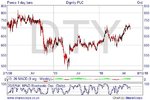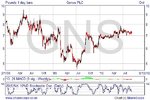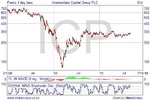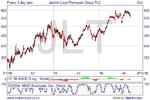Lol Sam, you flatter me. It's nothing to do with brain power, it's just that I've got experience in the application of hard-core maths. People with far greater brain power than I have developed techniques to analyse data environments as illogical and complex as the markets, I'm just pinching a few of their tools and applying them in a way I've been taught how.
So here's some stats for you, and a question I'm throwing out there.
In spreadbetting terms, I'm not sure how to define starting capital for a leveraged product.
On average, each trade would require a deposit of about £200, so to trade the 6 securities I'd need an account balance of £1,200, assuming that all 6 would have simultaneous open positions at some point.
The maximum stop loss value that any of the trades can hit is £250, so an account balance which is certain to cover all normal stop losses (assuming that all 6 securities were in open positions at once and stopped out at once) I'd need an account balance of £1,500.
In the event that the basket of 6 were all suspended at the same time and I was charged the full amount of the investment then I'd need an account balance of approximately £21,000.
I'm not sure what the protocol is, how to define my starting capital. For my own purposes I'm planning on keeping a balance on account that covers the potential of all trades being stopped out at the same time, so £1,500. That's got quite a lot of margin in it as I assume 5% slippage, and the £250 maximum loss is rare, the average loss is closer to £100.
In the month of back testing the method gave me 14 entry signals that were closed out before the end of the test month. Of these 14, 8 resulted in successful trades. A success ratio of 57% is hardly something to get excited about, but my average profit was £227.10 per successful trade, and the average loss was £100.58 per losing trade. The average result of all closed trades was +£86.66. I can afford my success ratio to drop as low as 30% and still breakeven if that profit to loss average stays as it is.
Now, I need a little help here. I want to define a performance indicator that I can use to measure whether the average result is getting better or worse as I adjust things that I think will improve my success ratio. I thought maybe a Sharpe ratio would do the trick, but I'm not sure how to calculate it. Wikipedia didn't help, even though it has the formula, as it doesn't give a good definition for the variables.
What I'm trying to achieve is this: I'll be adjusting my entry criteria to see if I can improve the 57% success ratio. If I achieve a 75% success ratio, but it makes my average loss bigger than my average profit, then the method has become less successful rather than more successful. I can make up an indicator of my own to monitor this, but if somebody has already invented one, I may as well use the industry standard tool.
So, the Sharpe ratio. I know lots of people spit feathers at the thought of it telling you something useful, but it looks like a tool that will fit this particular job. The wikipedia version of a Sharpe ratio includes a variable for an alternative risk-free return, as I'm short-term swing trading small values, I'm taking this variable to be negligible.
Tim's trade plan template says that I can calculate the Sharpe ratio by: "divide the average £££'s gained on profitable trades [£227.10] by the combined figure of the average number of £££'s gained and lost [? is this £86.66, the average return over all 14 trades, or £126.52, the combined total of £227.10 the average profit and -£100.58 the average loss?] and then multiply by 100". Using this method my Sharpe ratio is either 2.6:1 or 1.8:1. I suppose it doesn't really matter, so long as I apply the calculation consistently. I want it moving as close to 1:1 as possible don't I? That would be the result if every trade was a profitable trade. Hmm, what I've read suggests that a higher ratio is a better ratio, so something's not right here.
Suggestions would be appreciated, I'm quite happy to look at alternatives to the Sharpe ratio that tell me whether or not my tinkering is working. Meanwhile, I'm a week into paper trading the details of my trading plan while I'm writing it.
Cheers,
Sal




